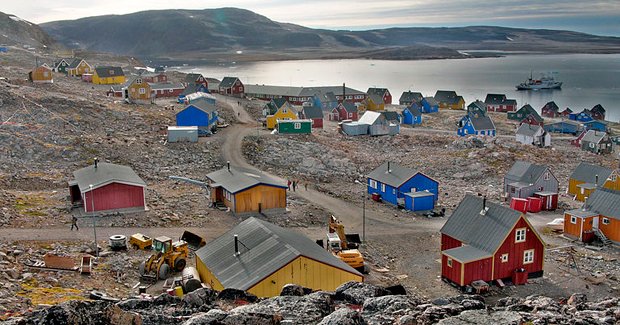Arctic jewels: living the Inuit way

Regular Australian Geographic contributor Ken Eastwood spent 14 days sailing around Iceland, Greenland and Spitsbergen on an AG Society expedition in September 2011. Read the full story in issue 106 of Australian Geographic and find more details about going on the 2012 expedition below.
ONE OF THE MOST noticeable differences between the Arctic and the Antarctic is the long history of human occupation here. A particular joy of this expedition is encountering human occupation sites that are hundreds or thousands of years old, as well as encountering the living Inuit culture here at Ittoqqortoormiit (prounounced ‘E-took-a-tour-mit’), one of the most remote settlements in Greenland.
The colourful village was founded in 1925, as an attempt to ease pressure on hunting grounds and living conditions at Tasiilaq, 400km to the north. Today it has about 450 residents, a 10-room guesthouse, a school, a comfortable nursing home with six residents, a playground and a gym.
There are also a host of Greenland dogs which are bred and harnessed together in teams of about a dozen to carry freight, tourists or hunters. During the three light summer months, the dogs are given a well-earned rest, and do little more than climb on and off the roof of their kennels and howl for their tucker.
Subsistence hunting in the Arctic
Like many indigenous peoples throughout the world, the Inuit here carry on many of their ancient traditions in a modern setting. So although they sit on Facebook or watch TV via large satellite dishes, hunting is still a necessary part of life (only two supply ships reach them a year). Using rifles and motorboats, rather than harpoons and kayaks, they kill minke whales, walruses, musk ox and polar bears.
Officially, only ‘professional’ hunters are allowed to make the kill, and numbers are limited to five minke whales a year and 30 polar bears (out of about 100 or so polar bears legally killed in all of Greenland). Outsiders don’t really know if these quotas are followed.
The day before we arrived, hunters in the village had killed two minke whales, and as we leave the town, we watch six dinghies chase another minke, rifle shots ringing out each time it surfaces.
Within just a few minutes spent in the town museum – as I admire the warmth of the vast hand mitts made out of polar bear skin – I am offered a whole polar bear skin for about $1800. Of course, even if I was interested, it is illegal to bring such items into Australia. The skins are generally either used in town or sold elsewhere in Greenland.
Although not a hunter, the museum guide Donny Bronlund was keen to emphasise the value of polar bear meat and its thick layer of fat. “It is good meat – makes you strong. Gives the hunter big hands and strong. It’s good in winter, we not very freezing because we eating polar bear,” he tells me. “We eating fat. Seal – lots of fat and meat. But the best meat is the musk ox.”
Isolated existence in the Arctic
Up the hill a bit from the museum, our expeditioners get a chance to sample the delicious musk ox meat, which tastes like hearty beef. Most of us politely refuse the accompanying narwhal.
There is no doubt it is a tough, isolated existence, with months of complete darkness, temperatures of -30ºC and winds up to 200km/h. During winter the village usually receives a few metres of snow, and villagers will either use skidoos or sleds to get around. During the summer, the townfolk get around mainly on four-wheelers or in their boats.
Elsewhere on the coastline, our expedition encounters evidence of other people who have persevered in these tough conditions, over Greenland’s 5000-year human history. At Eskimo Bay, we pass Eskimo rock-wall ruins estimated to be 1000 years old. The simple shelters had a buried entrance through which you would crawl, and would have had a skin covering over the rock walls.
At Syd Kap, we spy graves, hundreds of years old, where moss-covered skulls (below) and other bones are lying in rocky piles among a floral feast of yellow saxifrage, mountain avens and Arctic willow. It is both haunting and intensely beautiful.
RELATED STORIES



